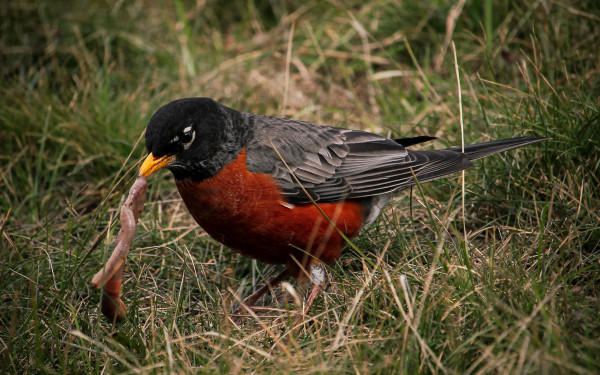A Look at Endangered Species in Montreal
Flora and Fauna That Need a Helping Hand
According to Jason Di Fiore, a biologist and general director of Héritage Laurentien, the brown snake is the rarest snake in Quebec.
“This small nocturnal reptile is actually a true urban snake, limited to the Montreal area in the province,” he said. “We could say that the brown snake is a true Montrealer!”
In its efforts to conserve the brown snake, Héritage Laurentien performed a two-step study on its populations in LaSalle, Verdun, and southwest Montreal.
“Little was known about these populations, so the first step was to identify the areas used by the snakes,” he said. The group installed more than 600 roofing shingles along the St. Lawrence River’s shoreline, from Lachine to the Champlain Bridge, including Nuns’ Island. They used shingles because they offer high-quality hiding and basking habitat for the snakes to gather underneath.
This first step made it possible to identify eight distinct brown snake populations in the area, Di Fiore said.
“The second step was a capture-marking-recapture study. The idea is to capture all the snakes, marking them, then releasing them,” he said. After a few visits, they were able to determine the number of individuals in the given brown snake population.
After conducting this study over the eight populations identified in the first step, Héritage Laurentien concluded four of the eight populations “were composed of more than 100 individuals, one capping at nearly 200,” said Di Fiore.
Saving the seagull’s classy cousin
Along with the brown snake, Héritage Laurentien is also working to conserve the common tern, even though it isn’t endangered.
The common term, visually similar to a ring-billed gull, nests on Mud Pie Island, located in the Lachine Rapids. It faces many challenges there, putting it at risk. “The main factors are predation and competition from ring-billed gulls and the loss of quality habitat,” Di Fiore said.
“The digging of the St. Lawrence Seaway created a lot of small islands, which provided perfect nesting habitat for the ring-billed gulls,” he continued.
“This, among other factors, like dumping grounds and feeding, [led] to an exponential population of gulls in Montreal,” and now they crowd the Montreal sky.
Ring-billed gulls are opportunists and have low standards when it comes to choosing a nesting area, according to Di Fiore. They migrate back to Montreal a month before the common terns, which are more selective about where they nest. Over the years, the ring-billed gulls have taken over all of the common tern-approved nesting spots.
Because of this, the population of the common tern has almost disappeared.
A survey conducted on the Lachine Rapids in 1998, prior to the control of the ring-billed gull, concluded there were only 48 common tern nests.
The following year, Pierre Mousseau, an ornithologist, came up with a solution to the problem at hand: install a repulsive structure on the sites early in the spring, when the ring-billed gulls are returning from their migration. This scares them away. The structure is then removed once spring’s first common tern is seen in Montreal.
This method led to a significant reduction of ring-billed gull nests on Mud Pie Island, and a steady increase in the common tern colony. In 2014, around 525 common tern nests were recorded. The project’s instigator retired in 2014, then Héritage Laurentien took over.
Going wild for wildflowers
Héritage Laurentien works not only with fauna, but with flora as well.
The American water-willow is an aquatic plant that blooms small white and lavender flowers and grows in dense colonies. The plant is considered threatened on both provincial and national levels.
Decades of development have rendered this plant almost extinct. Now, it’s only found in three locations: along the Rivière des Mille Îles separating Laval from Terrebonne, the Nicolet River neighbouring the Bécancour area, and on Rock Island in the Lachine Rapids. “Héritage Laurentien is working on the latter,” said Di Fiore.
“Our team of biologists and wildlife technicians identify two major threats to this colony, both linked to human activities,” he explained.
First, there has been a direct destruction of wildflowers brought on by kayakers, surfers, paddle-boarders, and jet ski users trying to access the island and often leaving their boats right in the plant colony.
Second, there has been a rise in the presence of the common reed—a plant that grows tall and has a tuft of seeds at the top. The common reed is an invasive plant brought onto Rock Island by human activity that competes with the water-willow.
“Our specialists evaluated the threat as very high, and protecting this specific population became a top priority for Héritage Laurentien,” he said.
The organization has benefited from the Habitat Stewardship Program for Aquatic Species at Risk, a federal program established in 2000. After receiving aid from the program, Héritage Laurentien started a three-year conservation strategy for the American water-willows on Rock Island—an admittedly ambitious project worth more than $100,000 over three years, said Di Fiore.
“We’ve filled up our island with concrete surfaces and not enough natural surfaces. Now we have to manage all of that rain water.”
— Sue Stacho
He said the project includes a survey of the water-willow population, a permanent dock to prevent boats from getting on the island through the plants, a guardian during the summer to raise awareness with the site’s users, measures to control the common reed population, and training the kayak and surfboard rental company’s staff to inform clients about the presence of the water-willow.
“So far, the results are amazing. Rock Island’s users are much more aware of the importance to protect the American water-willow,” he said. “There is still some work to do, and we are currently working on extending the project for another three years.”
Protecting greener pastures in l’Anse-à-l’Orme
In the borough of Pierrefonds-Roxboro, the City of Montreal was planning to develop more than 5,000 housing units on 185 hectares of unused agricultural land, adjacent to an ecologically rich forest in l’Anse-à-l’Orme.
Sauvons l’Anse-à-l’Orme was created primarily to combat the housing project, but also to enrich the land in l’Anse-à-l’Orme. The housing project would have stretched from the east of the Elm River to western Pierrefonds, according to Sue Stacho co-founder of Sauvons l’Anse-à-l’Orme.
“Our mandate was to lobby, raise awareness with the public, but also be a pain in the politicians’ butt,” said Stacho.
Pierrefonds experienced recurring flooding, a calamity for many residents, but Stacho thinks it encouraged Valérie Plante to side with Sauvons l’Anse-à-l’Orme.
“If the housing development went through, the 10,000-plus people living there would be in a prime flooding zone,” said Stacho. “When the municipal elections came around in 2017, we had Projet Montréal already well on board with protecting the land. When [Plante] became mayor, we were in. […] She followed through with her promise, which is the first time I’ve ever seen that happen.”
Because the land was left untouched by developers, the open fields were able to absorb some of the water overflowing from the Rivière-des-Prairies during the 2017 floods.
When flood water hits concrete, Stacho said, it has to flow down to the street, to the sewer, through to pipes, then to the river. In turn, the river overflows because it’s taking in too much water. With open fields, however, water flows more gradually into the river, so it does not get overwhelmed as quickly.
“We’ve filled up our island with concrete surfaces and not enough natural surfaces. Now we have to manage all of that rain water,” she said. “When you have vast areas that are left natural, it’s managing the water.”
Most of the species living in the site neighbouring the l’Anse-à-l’Orme Nature Park are endangered because of a loss of habitat, said Stacho.
What’s a bobolink bird without a meadow?
Amongst the animals living on the site is the bobolink bird. These, Stacho explained, nest in meadows.
“Meadows occur when land has been cultivated and left to grow back. Even in cultivated land, bobolinks will nest. […] As long as that grass, that growth is not cut back, the bobolinks have their nesting site,” explained Stacho.
“They live right on the edge of fields; they’re very vulnerable. Their nesting sites are often damaged from agricultural practices,” she
said.
L’Anse-à-l’Orme is full of meadows, making it perfect for bobolinks. Terrain like this is rare in Montreal, making this site unique. The land was being cultivated up until the early 2000s, said Stacho, and has been regrowing since.
“The land is coming back to the forest, and it supplies habitat for all different kinds of wildlife,” she said.
Stacho feels it’s important for everyone to connect with nature and grow attached to the greenspaces around them.
People already have an innate love for animals and pretty pictures, but to be standing in a wide-open field—watching the grass move, looking up at the vast open sky above you—feels special, she said.
“There are very well-established paths. They look kind of like tractor roads that were used by the farm owners in the past. You can follow those—you can veer off into the tall grasses of some of the fields. Each field is lined with trees. […] Those edges are really cool, too, because they’re really wild and gnarly trees with vines growing all over,” she said.
The forested area of the site has been protected for a long time, Stacho explained, meaning it’s grown much denser than the rest of the area.
“If you veer off into that, then you’re under this canopy of century-old trees,” she said. “The nice thing about summer is that the forest gets a break from us, because it’s so buggy.”
The wetlands nearby contribute to the abundance of insects found in the forest. While the bugs drive the humans out, they present birds with a wide array of dinner options.
Shoreline birds and frogs live in the site’s wetlands. There’s also a river within the site, which also lives in the site’s wetlands, is in decline because its habitats around Montreal are either being filled or dried up, said Stacho.
The fields, forest, and wetlands have created a buffet for all of the animals living in the site. In the spring, bees and other pollinating insects turn the fields into blossoming gardens.
Until recently, the protected site neighboured private property. According to Stacho, the municipal government has purchased the private property from its owners to grow the size of the protected site and add it to the park.
Connecting with the greenspaces in Montreal runs through the core of saving the city’s endangered species.
Walking through the site in L’Anse-à-l’Orme or the trails on Mount Royal raises one’s awareness of the flora and fauna living here. Keeping the environment in mind is a small action anyone can do, and it can cause a great ripple effect.


_600_832_s.png)

_600_375_90_s_c1.jpg)


_600_375_90_s_c1.jpg)